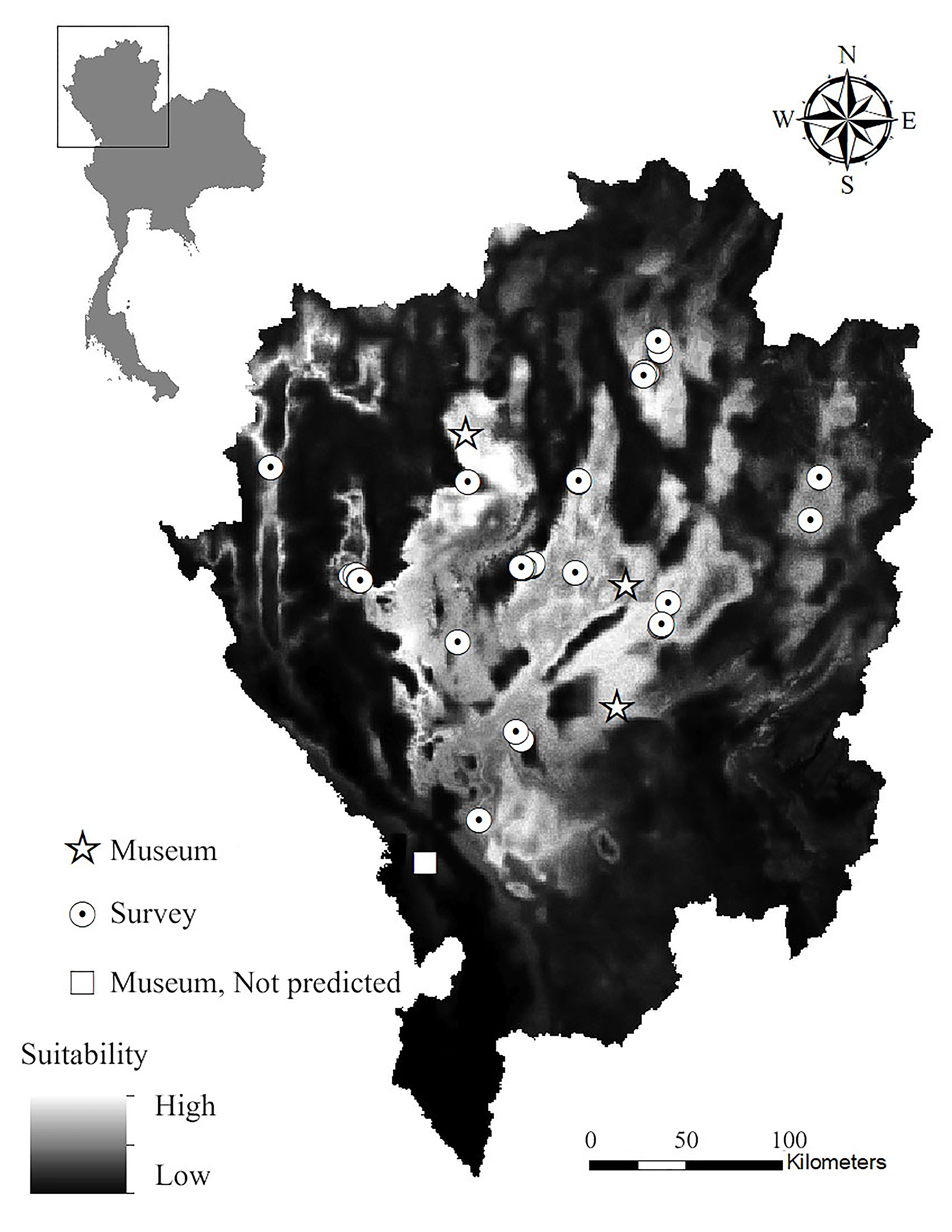Predicting Potential Distribution of an Endemic Butterfly Lizard, Leiolepis ocellata (Squamata: Agamidae)
DOI:
https://doi.org/10.58837/tnh.20.1.198819Keywords:
Leiolepis ocellata, Distribution modeling, Maxent, northern ThailandAbstract
Predicting available habitat and the fine scale distribution of an endemic butterfly lizard, Leiolepis ocellata, is important for conservation since its populations are experiencing threats from anthropogenic activities. We conducted field surveys in northern Thailand and detected L. ocellata at 15 of 16 surveyed localities. We then used Maxent to predict its potential distribution based on presence-only data collected from field surveys and museum specimens and predictor variables (19 bioclimatic variables). The most optimal model confirmed its geographic distribution in northern Thailand but absent from other regions in the country supported by high AUC (0.875±0.076). The most important predictor variable was isothermality followed by temperature annual range and precipitation seasonality. Its occurrence was corresponded with known sites for the species. One further site, from which an old specimen was collected and recorded in 1967, was not predicted by the model and disappeared during field surveys. Most predicted distribution range located outside protected areas, which may potentially disturb L. ocellata populations. Our results presented updated information on current occurrence and predicted distribution of L. ocellata in northern Thailand, which is useful for developing conservation strategy of this species.
References
Angilletta, M.J., Niewiarowski, P.H. and Navas, C.A. 2002. The evolution of thermal physiology in ectothermms. Journal of Thermal Biology, 27: 249-268.
Aranyavalai, V. 2003. Species diversity and habitat characteristics of butterfly lizards (Leiolepis spp.) in Thailand. Unpublished doctoral dissertation. Chulalongkorn University, Bangkok.
Buckley, L.B., Rodda, G.H. and Jetz, W. 2008. Thermal and energetic constraints on ectotherm abundance: a global test using lizards. Ecology, 89(1): 48-55.
Burgman, M.A., Lindenmayer, D.B. and Elith, J. 2005. Managing landscapes for conservation under uncertainty. Ecology, 86(8): 2007-2017.
Chan-ard, T., Parr, J.W.K. and Nabhitabhata, J. 2015. A field guide to the reptiles of Thailand. Oxford University Press, New York.
Das, I. 2010. A Field Guide to the Reptiles of South-East Asia. New Holland Publisher (UK) Ltd, London.
Elith, J. and Graham, C.H. 2009. Do they? How do they? Why do they differ? On finding reasons for differing performances of species distribution models. Ecography, 32: 66-77.
Eskildsen, A., Roux, P.C., Heikkinen, R.K., Høye, T.T., Kissling, W.D., Pöyry, J., Wisz, M.S. and Luoto, M. 2013. Testing species distribution models across space and time: high latitude butterflies and recent warming. Global Ecology and Biogeography, 22(12): 1293-1303.
Fick, S.E. and Hijmans, R.J. 2017. WorldClim 2: new 1-km spatial resolution climate surfaces for global land areas. International Journal of Climatology, 37(12): 4302-4315.
Grismer, J.L., Bauer, A.M., Grismer, L.L., Thirakhupt, K., Aowphol, A., Oaks, J.R., Wood, P.L., Onn, C.K., Thy, N., Cota, M. and Jackman, T. 2014. Multiple origins of parthenogenesis, and a revised species phylogeny for the Southeast Asian butterfly lizards, Leiolepis. Biological Journal of Linnean Society, 113(4): 1080-1093.
Guisan, A. and Zimmermann, N.E. 2000. Predictive habitat distribution model in ecology. Ecological Modelling, 135(2-3): 147-186.
Gül, S. 2015. Potential distribution modeling and morphology of Pelias barani (Böhme and Joger, 1983) in Turkey. Asian Herpetological Research, 6: 206-212.
Javed, S.M., Raj, M. and Kumar, S. 2017. Predicting potential habitat suitability for an endemic gecko Calodactylodes aureus and its conservation implications in India. Tropical Ecology, 58(2): 271-282.
Khanum, R., Mumtaz, A.S. and Kumar, S. 2013. Predicting impacts of climate change on medicinal asclepiads of Pakistan using Maxent medeling. Acta Oecologica, 49: 23-31.
Lutterschmidt, W.I. and Hutchison, V.H. 1997. The critical thermal maximum: history and critique. Canadian Journal of Zoology, 75(10): 1561-1574.
Manel, S., Williams, H.C. and Ormerod, S.J. 2001. Evaluating presence-absence models in ecology: the need to account for prevalence. Journal of Applied Ecology, 38(5): 921-931.
Manthey, U. 2010. Agamid Lizards of Southern Asia. Draconinae 2– Leiolepidinae. Terralog 7b, Chimaira, Frankfurt.
O’donnell, M.S. and Ignizio, D.A. 2012. Bioclimatic Predictors for Supporting Ecological Applications in the Conterminous United States. U.S. Geological Survey Data Series, 691, Reston.
Pauwels, O.S.G. and Chimsunchart, C. 2007. Die Augenfleck-Schmetterlingsagame Leiolepis ocellata Peters, 1971 in Thailand. Elaphe 15(1): 60-62.
Peter, V.G. 1971. Die intragenerischen Gruppen und die Phylogenese der Schmetterlingsagamen (Agamidae: Leiolepis). Zoologische Jahrbucher Sysematik, 98:11-130.
Phillips, S.J., Anderson, R.P. and Schapire, R.E. 2006. Maximum entropy modeling of species geographic distributions. Ecological Modelling, 190(3-4): 231-259.
Ponder, W.F., Carter, G.A. and Chapman, R.R. 2001. Evaluation of museum collection data for use in biodiversity assessment. Conservation Biology, 15(3): 648-657.
Shine, R. 2005. Life-history evolution in reptiles. Annual Review of Ecology Evolution and Systematics, 36: 23-46.
Spellerberg, I.F. 1971. Temperature tolerances of Southeast Australian reptiles examined in relation to reptile thermoregulatory behavior and distribution. Oecologia, 9(1): 23-43.
Swets, J.A. 1988. Measuring the accuracy of diagnostic systems. Science, 240(4857): 1285-1293.
Tiedemann, F., Häupl, M., and Grillitsch, H., 1994. Katalog der Typen der Herpetologischen Sammlung nach dem Stand vom Jänner 1994, Teil II: Reptilia. Kataloge der wissenschaftlichen Sammlungen des Naturhistorischen Museums in Wien, Wien (Naturhistorisches Museum Wien), 10 (Vertebrata 4): 110.

Downloads
Published
How to Cite
Issue
Section
License
Chulalongkorn University. All rights reserved. No part of this publication may be reproduced, translated, stored in a retrieval system, or transmitted in any form or by any means, electronic, mechanical, photocopying, recording or otherwise, without prior written permission of the publisher











